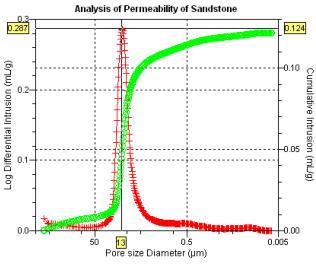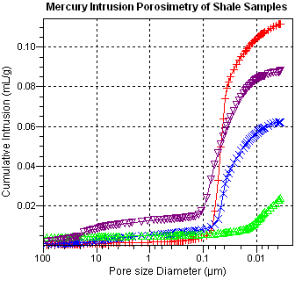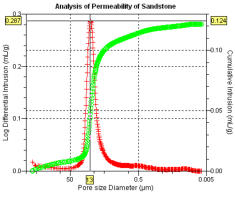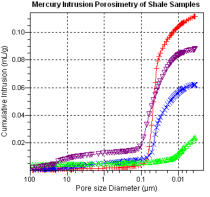




Expertise in the Physical
Characterisation of Materials

MCA Services
Unit 1A Long Barn, North End, Meldreth, Cambridgeshire SG8 6NT UK
01763 262333
© MCA Services




The
porosity
of
geological
samples
if
often
of
critical
interest
to
many
fields
of
geology,
for
example
geochemistry,
environmental
and
engineering
geology,
hydro-geology,
petrology,
and
both
conventional
and
unconventional
energy
etc.
The
pore
volume
and
pore
size
distribution
characteristics
is
often
of
primary
influence
top
the
physical
properties
of
rock
samples
and
the
flow
and
retention
behaviour
of fluid through them.
Key Techniques
•
BET Surface Area - including krypton adsorption for low area materials
•
Mercury Porosimetry - for pore size, pore volume & pore area distribution
•
Mercury Porosimetry - for cavity to throat size evaluation
•
Permeability and Tortuosity measurement via Mercury Porosimetry & Pycnometry
•
Gas Adsorption - pore size, area and volume distribution in the mesopore range
•
Micropore Analysis - pore size, area and volume distribution
•
Density measurement - absolute density, bulk density & skeletal density
•
Measurement of Total Pore Volume
•
Specific probe gases, e.g. H2, CO2, O2 etc available for adsorption capacity measurement
MCA
Services
offers
a
complete
suite
of
techniques
for
the
characterisation
of
material
porosity
throughout
the
range
of
micropores,
through
mesopores,
to
macropores.
We
also
have
the
experience
and
expertise
to
actively
assist
with
interpretation
of
results
and
gain
maximum
benefit
through
application
of
state-of-the-art
software
to
obtain
highly
specialised report and graphical formats.
P
orosimetry
techniques
have
been
applied
to
geological
samples
of
high
porosity,
such
as
sandstones
and
chalks,
through
to
relatively
non-porous
materials
such
as
tight
shales.
The
techniques
have
also
been
of
considerable
benefit
in
evaluating
the
effects
of
treatments on construction materials, such as concretes and ceramics.
The
application
of
mercury
intrusion
porosimetry,
in
combination
with
helium
pycnometry,
is
particularly
suited
to
the
measurement
of
the
permeability
of
geological
samples.
Further
combination
with
BET
surface
area
also
allows
for
the
assessment
of
tortuosity.
These
techniques
provide
for
relatively
rapid
measurement
with
the
additional
benefits of providing the pore size, volume and area distributions of the samples.
As
the
possibilities
of
extraction
from
shale
increase,
so
too
does
the
interest
in
their
characterisation.
Analysis
of
pore
size
and
pore
area
distributions
provides
critical
data
in
the
assessment
of
their
storage
capabilities.
Pore
sizes
are
typically
<
2μm,
often
with
a
significant
distribution
in
the
mesopore
range.
Mercury
porosimetry
provides
a
powerful
analytical
tool
for
measuring
of
pore
volume
and
area
distribution,
sample
density
and
cavity
to
throat
size
characteristics.
Gas
adsorption
provides
complete
mesopore
distributions
and
the
extension
to
dedicated
micropore
analysis
if
micropore
volume
and
area
distributions
are
required.
Specific
probe
gases,
such
as
carbon
dioxide,
hydrogen
and
oxygen
can
also
be
applied
to
evaluate
adsorption
capacity.


Geological Analysis





Expertise in the Physical
Characterisation of Materials
MCA Services
Unit 1A Long Barn, North End,
Meldreth, Cambridgeshire SG8 6NT UK
01763 262333
© MCA Services




The
porosity
of
geological
samples
if
often
of
critical
interest
to
many
fields
of
geology,
for
example
geochemistry,
environmental
and
engineering
geology,
hydro-geology,
petrology,
and
both
conventional
and
unconventional
energy
etc.
The
pore
volume
and
pore
size
distribution
characteristics
is
often
of
primary
influence
top
the
physical
properties
of
rock
samples
and
the
flow
and
retention
behaviour of fluid through them.
Key Techniques
•
BET Surface Area - including krypton adsorption
•
Mercury Porosimetry - for pore size, pore volume & pore area
distribution
•
Mercury Porosimetry - for cavity to throat size evaluation
•
Permeability and Tortuosity measurement via Mercury
Porosimetry & Pycnometry
•
Gas Adsorption - pore size, area and volume distribution in the
mesopore range
•
Micropore Analysis - pore size, area and volume distribution
•
Density measurement - absolute (grain) density, bulk density &
skeletal density
•
Specific probe gases, e.g. H2, CO2, O2 etc available for adsorption
capacity measurement
•
Measurement of Total Pore Volume
MCA
Services
offers
a
complete
suite
of
techniques
for
the
characterisation
of
material
porosity
throughout
the
range
of
micropores,
through
mesopores,
to
macropores.
We
also
have
the
experience
and
expertise
to
actively
assist
with
interpretation
of
results
and
gain
maximum
benefit
through
application
of
state-of-the-
art software to obtain highly specialised report and graphical formats.
Porosimetry
techniques
have
been
applied
to
geological
samples
of
high
porosity,
such
as
sandstones
and
chalks,
through
to
relatively
non-porous
materials
such
as
tight
shales.
The
techniques
have
also
been
of
considerable
benefit
in
evaluating
the
effects
of
treatments
on
construction materials, such as concretes and ceramics.
The
application
of
mercury
intrusion
porosimetry,
in
combination
with
helium
pycnometry,
is
particularly
suited
to
the
measurement
of
the
permeability
of
geological
samples.
Further
combination
with
BET
surface
area
also
allows
for
the
assessment
of
tortuosity.
These
techniques
provide
for
relatively
rapid
measurement
with
the
additional
benefits
of
providing
the
pore
size,
volume
and
area
distributions of the samples.
As
the
possibilities
of
extraction
from
shale
increase,
so
too
does
the
interest
in
their
characterisation.
Analysis
of
pore
size
and
pore
area
distributions
provides
critical
data
in
the
assessment
of
their
storage
capabilities.
Pore
sizes
are
typically
<
2μm,
often
with
a
significant
distribution
in
the
mesopore
range.
Mercury
porosimetry
provides
a
powerful
analytical
tool
for
measuring
of
pore
volume
and
area
distribution,
sample
density
and
cavity
to
throat
size
characteristics.
Gas
adsorption
provides
complete
mesopore
distributions
and
the
extension
to
dedicated
micropore
analysis
if
micropore
volume
and
area
distributions
are
required.
Specific
probe
gases,
such
as
carbon
dioxide,
hydrogen
and
oxygen
can
also
be
applied
to
evaluate
adsorption capacity.




01763262333
Geological Analysis





















